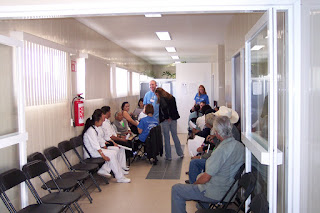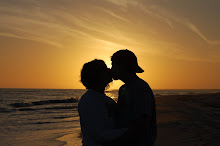I just got back from a week in Guanajuato, Mexico. I traveled with VOSH (Volunteer Optometric Service to Humanity) an organization from IU School of Optometry. I flew from Indianapolis to Dallas to Guanajuato on Saturday, March 1st. After arriving at the airport, vans drove us to the nearby clinic in Leon, Mexico. There we got our first tour of the clinic and unloaded the supplies that we had packed in our luggage. The rest of Saturday was a free day to settle in and explore the city of Guanajuato. Our vans again drove us to the hotel where we checked in. I shared a room with Heather, a second year optometry student. The rooms were not fancy but besides the hard mattresses, there wasn’t much to complain about. A group of us decided to walk into the downtown area of the city. The city of Guanajuato is built in a valley and up the sides of the two mountains. Our hotel was a fair distance up one of the mountainsides so we had a walk down a lot of stone stairs carved into the mountainside to get to the center of the city. The city itself was beautiful, and most of the residents were very nice and had the money they needed to buy the necessities (some were even very wealthy with large mansions on the mountainsides). We ate dinner at a restaurant on the main square. The square is called the jardin, which is Spanish for garden, because there is a beautiful garden area in the center of the square. I had a dish similar to fajitas for dinner that was very good. For the next five days, our routine was very similar. We got up around 6 am, got ready for the day and got on the vans at 7 am. We rode 15-20 minutes to the clinic in Leon, where breakfast was cooked for us. The entire week’s clinic was sponsored by DIF (Department of Infants and Families) in Mexico. They paid for our hotel, breakfast, lunch, and unlimited bottled water at the clinic. They also paid the van drivers, cooks, and translators who helped us when our limited Spanish wasn’t enough. For breakfast we had quite a variety including cereal, fruit, yogurt, pastries, eggs, spicy chicken, beef with green sauce, hot dogs, etc. By 8 am we were working in the clinic. Patients rode a bus from the rural villages into Leon, sometimes up to 6 hours one way. Students from the local Mexican nursing school checked the patients in, had them read the eye chart to get visual acuities and used a machine to estimate their prescription. The patients then lined up in chairs waiting to be seen. In the chairs we did some preliminary testing to check their eye movements and noted any external observations (such as growths, drooping eyelids, etc.) We also took their blood pressure. Then they were taken into one of two rooms were direct ophthalmoscopy was performed; this procedure allows us to view the inside of the eye to check for health. If everything appeared okay, they did not have to have their eyes dilated. If there were problems, they received drops to dilate their eyes. Often if the initial prescription estimate seemed incorrect, another step called retinoscopy was used to refine the prescription. Dilated patients were looked at in the slit lamp (like a microscope to view the inside of the eye). If anything interesting was seen, photos were taken. Another step that some patients went through was trial frame refraction (where you ask “which is better , one or two?) to further refine their prescription. Finally the patients were taken to a check out area where a doctor reviewed their chart and wrote the final prescription. They also determined whether it was necessary for a patient to return for a follow up or see the Mexican ophthalmologist. The final step was that the patients went to the dispensary area. In this area the prescription was typed into the computer and the computer printed a list of the top ten matches for glasses. We had 14,000 pairs of glasses on hand that had been collected by Lions Club. We chose 2 or 3 frames from the list and let the patient choose which frame they preferred. As a first year student, I worked in the dispensary a lot, but I was also able to do preliminary testing and take blood pressures. In the dispensary I learned a lot of Spanish and was lucky enough to meet some very grateful people. One woman kissed my hand and told me that she was very thankful. Another man gave me a hug and said he really appreciated all of us. In the preliminary testing I was able to observe many conditions that are very serious and rare in Indiana, but very interesting to see. In the blood pressure role, I was amazed at the number of people with very high blood pressure (greater than 200/100) that had to be referred to the medical doctor for medication. Every day sometime between noon and 2 pm we took turns eating lunch for 20-30 minutes. Lunch was again prepared for us and including a variety of local Mexican foods usually, but we did have hamburgers one day. After lunch it was again back to work in the clinic. We saw around 500 patients on Sunday, Wednesday, and Thursday and left the clinic around 5:30 pm. On Monday and Tuesday we saw 700 patients and were at the clinic until 7 or 7:30 pm. After the day at clinic was over, we rode vans back to our hotel and made dinner plans. Most nights we would walk 20 minutes into town to eat. We ate at several traditional Mexican restaurants (most of which were only decent), an Italian restaurant (which was great), and we ordered Dominos pizza (which was very expensive). We usually took a taxi back to the hotel because the steps back up the mountain were steep and long. Plus a taxi was only $1 each. The neat thing about the ride home was that we drove through underground tunnels. Since the city was built on mountainsides and fairly cramped, they built tunnels under the city for transportation. On Thursday night after we had finished our last day at the clinic, the government threw a big thank-you dinner for us. It was an amazing dinner and the Maestra (director) of DIF spoke to thank us for our work. We were presented with thank-you baskets with Mexican food and candy. The doctors of the clinic got really nice leather jackets. After the dinner and speeches, they started music and some people started to dance. They handed out glow-in-the-dark bracelets, crazy masks and balloons. On Friday we had a free day in the city. We walked around, went shopping, and ate lunch at a café. Before I knew it, it was Saturday and time to go back to Indiana. The flight home was on time and went fine. I was glad to be home to some food that settled better in my stomach, but I am excited to go back to work in the clinic again next year. We are already planning to do a sunglasses drive to get prescription and non-prescription sunglasses donated so that the patients can have sunglasses to protect their eyes.
Monday, March 10, 2008
VOSH Trip to Mexico
Posted by Kacie at 5:52 PM
Subscribe to:
Post Comments (Atom)



















1 comments:
Post a Comment